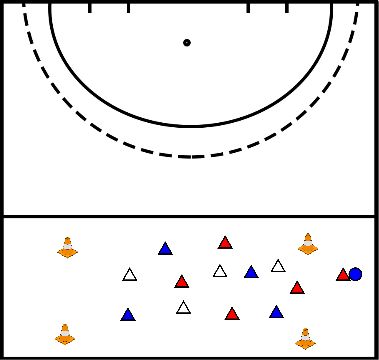Hockey drills
Red player starts with the ball and begins drifting to the next pot and then pushes the ball to the blue player.
The blue player takes open around the pot and then also drifts to the next pot and then pushes to red again!
The blue player takes open around the pot and then also drifts to the next pot and then pushes to red again!
- T: Give as many passes as possible within 1 minute.
- R: /
- A: Making the square bigger
- D: Passive defender
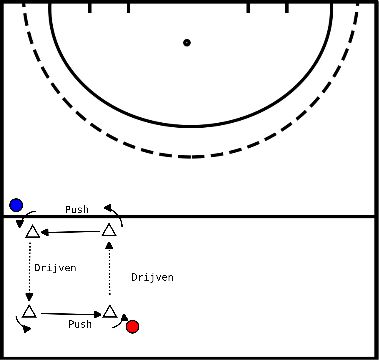
Stairs.
- Player blue starts with the ball at the orange pawn.
- Player blue drives the ball toward the red pawn, pulls the ball under him toward the blue pawn and then accelerates briefly with the backhand around the blue pawn.
- You do this movement three times in a row.
- Then you round on goal.
- Depending on the number of players, put the exercise out once or twice.
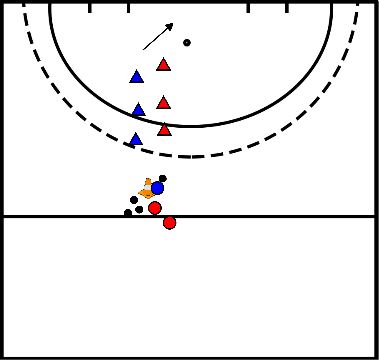
Minefield
- Start at the orange pawn and dribble through the minefield towards the goal.
- Keep the ball close to you and try to make sure you don't hit the pawns.
- Once you are past the minefield, round off with a hit on goal.
- Plot the exercise twice, if necessary.
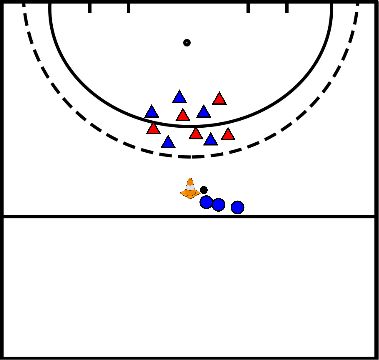
- Party game with two goals and a square in the middle of the field.
- The ball may not be played through the square. In that case the ball is in touch.
- So the idea is to play field hockey outside and not through the axis of the field.
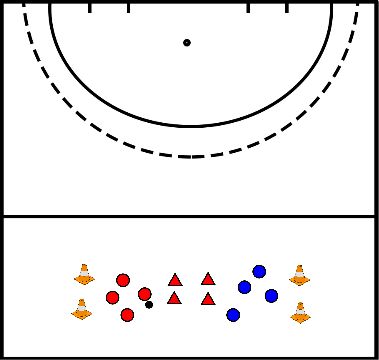
Relay
- Make two equal teams; team red and team blue.
- Start with ball at orange pawn.
- Float a lap around the green pawns and place ball with hand on pawn red.
- Then run a lap around the green pawns without ball and tap the blue pawn with your hand.
- Then walk another circle around the green pawns and take the ball off the red pawn.
- Then drive a circle around the green pawns with ball and pass the ball to the next one.
Note:
- Depending on the number of players, you can have everyone take 1, 2 or 3 turns.
- Once a player has had her/his last turn, she/he sits on the floor.
- If a team has all its players sitting on the ground, they win the relay.
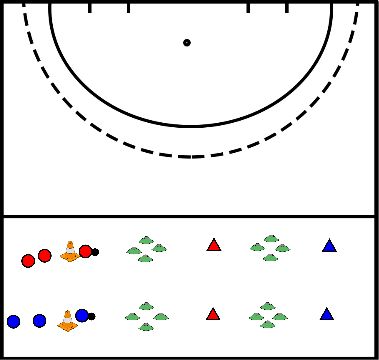
Three color game
- The trainer has three colors of pawns in his hand. Red, white and blue.
- Player blue A takes his turn.
- Trainer first puts color pawn 1 in the air --> For example, pawn white.
- Player blue A starts running towards the edge of the circle and receives the ball from player blue ->.
- The latter then plays the ball through the white gate as the trainer thus puts the white pawn in the air.
- Player A takes the ball through the gate and rounds on goal.
- After his shot, he takes over the spot of the player who passed the ball to him.
- The trainer puts a new color pawn in the air for the next player etc.
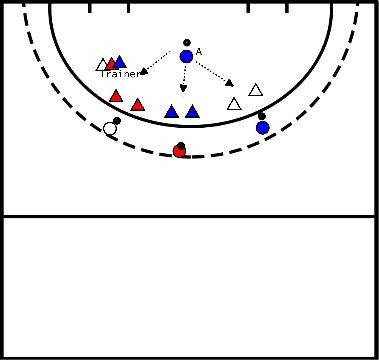
Relay 4
- Players blue and red start at the same time with the ball
- Slalom around the 5 pawns --> cross --> around the green pawn and finish on goal.
- If you score, you may immediately choose the shortest path to tap your next teammate.
- If you miss; wide, post or the ball does not reach the goal, you make a detour via the red or blue pawn/triangle.
- Players blue run back via the blue pawn and players red via the red.
- When you have been, you sit on the ground.
- The team that has all players on the ground first wins the relay.
- Depending on the number of players, you may choose to have all players take their turn twice.
- Switch sides halfway through the exercise.
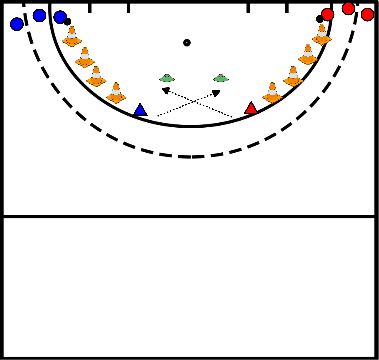
Rats versus Ravens
- Players red; the rats and players blue; the ravens all have a ball and stand with their backs to each other.
- Trainer says r(rrrr)atten: all red players drift with ball toward the pawn line; players blue leave their ball and try to tap players red for the line.
- The trainer says r(rrrr)aven: all blue players drive ball toward the pawn line; players red leave their ball and try to tap players blue for the line.
- Reach the line without being tapped, you get a point.
- Tap the player red/ blue before the line you get a point.
- Change opponents frequently.
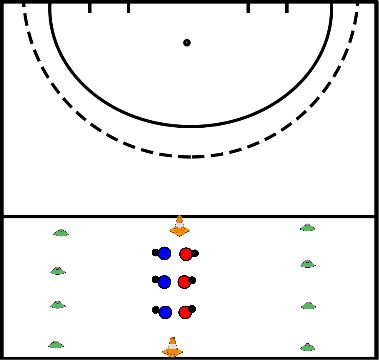
- Player blue 1 plays the ball with a controlled push or flats diagonally onto the forehand of player red 2.
- Player red 2 takes the ball on the forehand and rounds on goal.
- Player red 1 plays the ball with a controlled push or flats diagonally onto the backhand of player blue 2.
- Player blue 2 takes the ball on the backhand and rounds on goal.
Points of focus:
- The focus in this exercise is on the approach.
- Make yourself small when making the approach.
- Try to pick up the pace of the ball.
- Let the ball roll past you and take the ball as late as possible.
- Make sure that the ball does not rise when taking it on. So keep your stick straight and not angled.
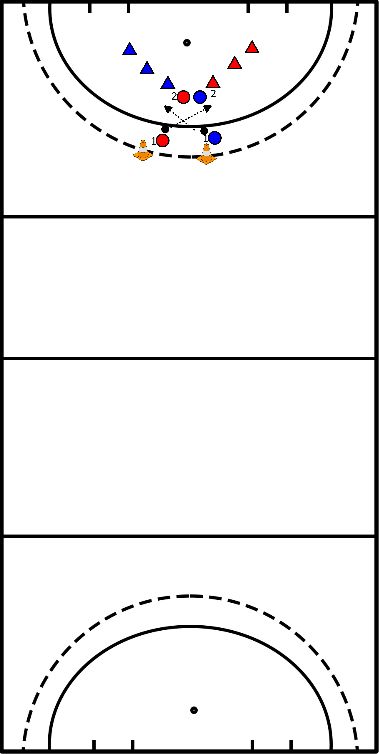
- All players start with a ball in the square and dribble/drive around in it.
- The trainer determines the moment to call stop!
- At that moment, all players make sure the ball is stopped as quickly as possible.
- Does the ball roll on. So does the player not have control of the ball he is off.
- When you are off, you wait by the side.
- The trainer may point to a waiting player to call stop!
- As a trainer, at some point you may indicate that the players should dribble faster.
- This makes it more difficult to stop the ball.
Note: the ball must be really still, so it should not roll a little bit.
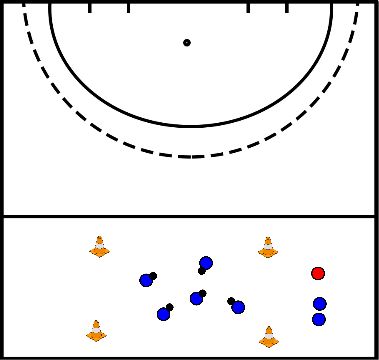
- Except for one player -red-, all players -blue- have one ball.
- The red defender tries to work all balls out of the box.
- If a blue player loses his/her ball and it has been played out of the box, she/he stands with her/his legs apart.
- The player can be redeemed by another blue player; This one plays the ball through the legs -panna- and blue has a player back in the box.
- Continue until all players are off.
Points of attention:
- If it takes too long or you notice in advance that one defender is too little, appoint an extra defender.
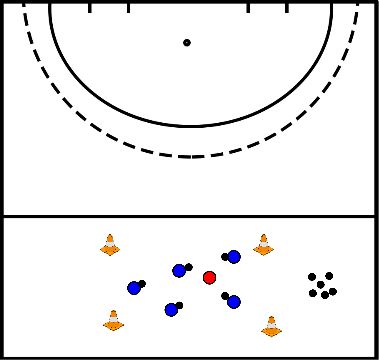
Three-color game
- Players all have a ball and dribble through the box of pawns.
- Scattered through the box are pawns of three different colors; at least 4 of each color.
- Trainer has in hand of all three colors -i.e. in the example red, blue and white.
- Trainer puts e.g. a blue pawn in the air --> All players try to drive around all blue pawns as quickly as possible.
- The first two players who have driven around all blue pawns get a point.
- Then a new round begins and the trainer chooses another color pawn -or the same color.
- Etc.
